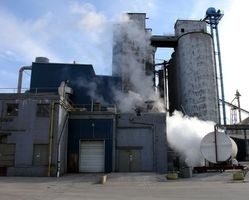Industrial Safety Risk Factors

Safety risk factors pervade industrial work zones. According to the United States Occupational Safety and Health Administration (OSHA), industrial environments can be dangerous because of the heavy machinery and equipment used by employees. OSHA says that each year around 18,000 industrial workers suffer laceration and amputation injuries.
Identification
To ensure a hazard-free work zone, employers must identify what safety risks exist in the work environment. Some safety risks include heavy machinery, electrical equipment, harmful substances and slip-and-fall accidents due to slippery, wet or unkempt walking surfaces.
Prevention and Solution
Preventing accidents and injuries can be accomplished by eliminating hazards from industrial work areas. Safeguarding machinery makes equipment safer to use by protecting critical points of operation. Personal protective equipment protects workers from exposure to harmful substances, which keeps them healthy and safe. Educating workers about safety practices and posting caution signs reduces risk factors.
Ongoing Safety Efforts
The assurance of safety is an ongoing effort. Employers must evaluate industrial work zones on a regular basis to look for any unidentified risk factors, such as defective equipment. It is also important for safety incidents to be reported so that employers are made aware of new safety risk factors.
Identification
To ensure a hazard-free work zone, employers must identify what safety risks exist in the work environment. Some safety risks include heavy machinery, electrical equipment, harmful substances and slip-and-fall accidents due to slippery, wet or unkempt walking surfaces.
Prevention and Solution
Preventing accidents and injuries can be accomplished by eliminating hazards from industrial work areas. Safeguarding machinery makes equipment safer to use by protecting critical points of operation. Personal protective equipment protects workers from exposure to harmful substances, which keeps them healthy and safe. Educating workers about safety practices and posting caution signs reduces risk factors.
Ongoing Safety Efforts
The assurance of safety is an ongoing effort. Employers must evaluate industrial work zones on a regular basis to look for any unidentified risk factors, such as defective equipment. It is also important for safety incidents to be reported so that employers are made aware of new safety risk factors.
- c24b5622d934259d92d25ed071c0973bc8.jpg
- sc55bf5de47fc803c375bab29e362965b0.jpg
Videos
References
http://www.ehow.com/facts_6891716_industrial-safety-risk-factors.html
http://safera.industrialsafety-tp.org/images/13/SAFERA/Risk2.jpg
http://img.ehowcdn.com/article-new-thumbnail/ehow/images/a06/ia/64/industrial-safety-risk-factors-800x800.jpg
https://www.youtube.com/watch?v=UdOqakav_aI